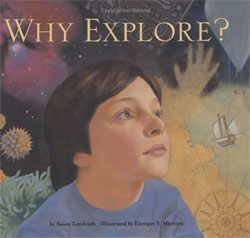
This book shows humans’ natural curiosity, their need to find out what is beyond their limits. Its premise is that exploring is good because it often leads to many new discoveries. This book also shows that when people ask questions, or when you are asking questions yourself, in a way you are exploring. Asking questions is like looking at something and knowing that there is something else to it. Exploring further extends your knowledge. So the next time someone is curious about what you’re doing or they are asking you a million questions, remember they are “exploring” and addressing a natural curiosity.
Each page of this picture book depicts one person questioning another on why they explore. When travelling is involved, the one staying behind argues that everything is O.K. right here so why travel? Fear of the unknown and its dangers keeps them home bound. For the ones leaving, the excitement of going, the fun of experimenting and the opportunity for a fresh start are what give them the impetus. The resonance of the book is that for people, it is natural to crave answers and to explore.
Understanding one’s own body and emotions is one of the greatest undertakings of any human. Whether young or old, they are always learning about themselves. Children, with their knack for asking the obvious, can shed more insight than a hundred doctoral candidates. As well, in helping children understand themselves, we understand ourselves better. This is the viewpoint taken by Lendroth and Moreiro. They show there is no one answer to the question, ‘Why Explore?”. Simply, for some there are many more advantages than in not exploring. The bigger quandary, though unaddressed, is why we keep questioning, why do we continually expect more.
A young child, 5 or 6 years old, would likely really enjoy reading this book with a learned adult. The large format, with reproductions of oil paintings filling every page’s background, makes for a visual treat. The short, rhyming text adds a sense of wonder and pleasure to challenging words like sharecropping and electron scattering. As children tend to be more curious with less patience, the few words and vivid art work would most likely well entertain them.
Picture books can teach children to count or recognize the primary colours. But more demanding books are those that try to broach the subject of emotions. Exploring and curiosity are such emotions and Susan Lendroth and Enrique Moreiro in their book Why Explore? comfortably and clearly let an older person discuss this concept with a younger one. After all, many of us, for whatever reason are not satisfied with the options at hand and are darn sure things could be better.
Review by Mark, Ariana and Lorelei Mortimer
Read more reviews online, or purchase a copy from Amazon.com.
